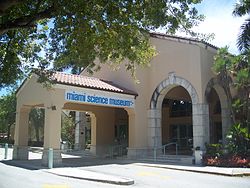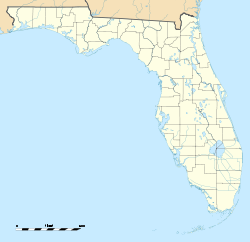- Miami Science Museum
-
Coordinates: 25°44′48″N 80°12′42″W / 25.74658°N 80.21157°W
Miami Science Museum 
Established 1949 Location 3280 South Miami Avenue
Miami, Florida, United StatesType Science museum Director Gillian Thomas Curator Sean Duran Public transit access Metrorail access at Vizcaya Station Website Miami Science Museum The Miami Science Museum is an attraction located in the city of Miami, Florida USA. The museum itself also contains the Space-Transit Planetarium, Weintraub Observatory and a wildlife center. The museum is currently working to transplant the museum from its current location to Park West at Bicentennial Park in Downtown Miami along with the Miami Art Museum. Construction is set to begin on the new museum in Downtown in late 2011, with a grand opening expected in late 2014.
The Miami Science Museum is served by the Miami Metrorail at the Vizcaya Station.
Contents
History
The Museum first started as "The Junior Museum of Miami" and was a private non-profit organization established in 1949. It was located inside a house on the corner of Biscayne Boulevard and 26th Street. The Museum grew so rapidly that in 1952 it relocated to the Miami Women's Club building on Bayshore Drive. When it arrived at the new location it was renamed "Museum of Science and Natural History".
In 1953, the Guild of the Museum of Science was formed adding the efforts of volunteer assistance to the staff, operation of the Museum Store, as well as tours and outreach programs.
The museum began to outgrow its new home again and a special committee headed by Claire Weintraub recommended that Miami should establish a major independent science museum which could service citizens of all ages. By 1960, the first building of the community's new science museum opened its doors. The facility was located on 3 acres (12,000 m2) of the historic Vizcaya complex, and was built and furnished rent-free by the County.
Late 1966 saw the construction of a Space Transit Planetarium, which soon became the leading facility of its kind in the world.[citation needed] Its activities now include international television programming (see Star Gazer).
In 1989, the Museum's lease agreement with the county for the Vizcaya site was extended for 99 years.
The yearly operating budget has grown to 2.5 million dollars, and the property currently totaling only 48,000 square feet (4,500 m2).
The museum currently showcase these exhibits:
- Stingray Sea Lab
- Earth from Space
- Room for Debate
- Heart Smart
- Energy Tracker
- Fuels of the Future
- Moving Things
In March 2011, Miamian Phillip Frost donated $35 million to the construction of the new Miami Science Museum in Downtown Miami. Frost's donation to the museum, is one of the largest donations to Miami's cultural institutions. The museum is expected to break ground in late 2011, to be completed by the end of 2014. The Miami Art Museum which is also building a new building in Bicentennial Park is a year ahead, with an expected completion in 2013.[1]
Planetarium
The planetarium was opened on November 4, 1966. It is home to Jack Horkheimer's Star Gazer, the world’s first and only weekly television series on naked-eye astronomy.[2] The projection dome room is 65' in diameter and has seating for over 230. It utilizes a Spitz STP (Space Transit Planetarium) star projector.
Gallery
References
External links
Categories:- Museums in Miami, Florida
- Planetaria in the United States
- Coconut Grove (Miami)
- Science museums in Florida
- Natural history museums in Florida
Wikimedia Foundation. 2010.



